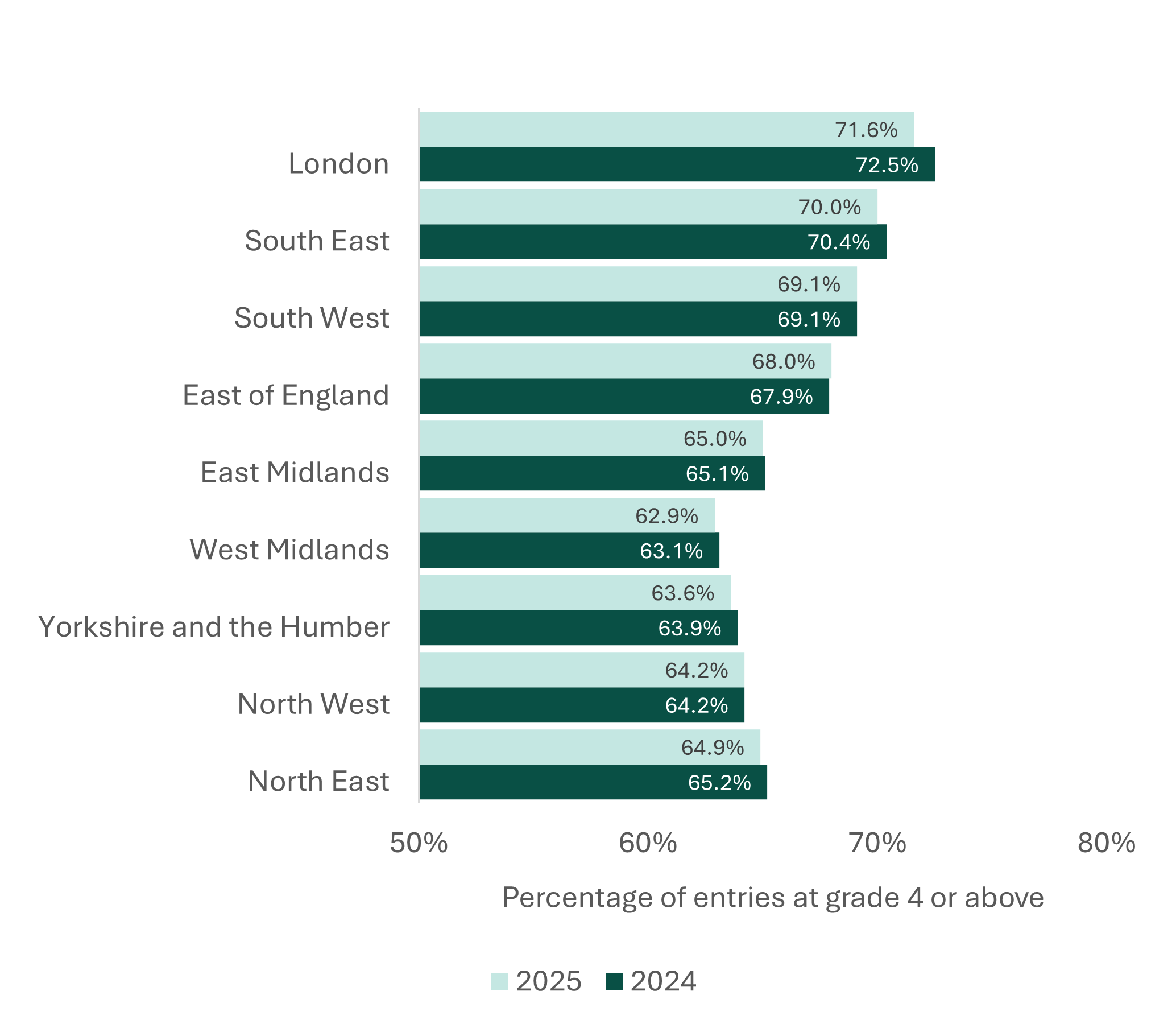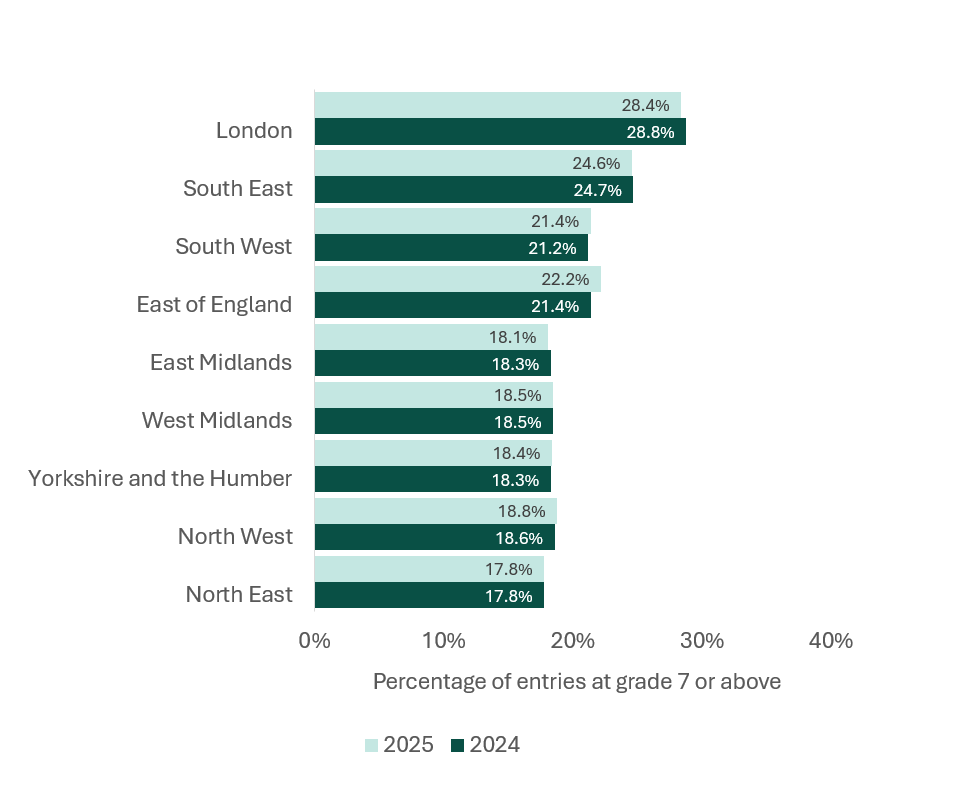Today, thousands of young people in England are receiving their results in GCSEs and level 1 and 2 technical awards. As ever, we will be publishing analysis of results through the day. For further background to today’s results, please see our preview.
Unless stated otherwise, our analysis refers to 16-year-olds in England.
Headline results are similar to last year
Overall, amongst 16-year-olds in England, 70.5 per cent of all awards were at grade 4 or above, this is just 0.2 percentage points higher than in 2024. At the higher end of the distribution there was a small increase, 23.0 per cent of all awards were at grade 7 or above, this is 0.3 percentage points higher than in 2024. (Note that some comparisons between years or between groups presented here may differ from headline results due to rounding).
We can also compare results back to 2019, the last set of results before the pandemic. We can see that the proportion of entries achieving any pass (grade 1 or above), was 98.2 per cent, down 0.3 per cent on 2019 but around the same as last year. The proportion of entries at grade 4 or above is 0.6 percentage points higher than 2019, and the proportion of entries at grade 7 or above is 1.2 percentage points higher than in 2019.
The average grade awarded in 2025 was 4.82, broadly the same as it was last year and the average grade prior to the pandemic. Following the use of centre-assessed grades in 2020 and teacher assessed grades in 2021, the average grade awarded was around half a grade higher in 2021 than it had been in 2019.
Most subjects have a similar grade distribution to last year
Almost all subjects have similar grade distributions to last year. The largest increases at grade 4 or above amongst larger GCSE subjects (those with at least 10,000 entries) were in German (up 2.2 percentage points), food preparation and nutrition (up 1.7 percentage points) and French (up 1.7 percentage points). The largest falls were in citizenship studies (down 0.7 percentage points), business studies (down 0.7 percentage points) and English language (down 0.6 percentage points).
However, English language did see an increase at the grade 7 threshold (up 0.5 percentage points). As at the grade 4 boundary, French and German also saw increases at grade 7 or above (up 1.7 and 1.6 percentage points respectively).
At grade 7 or above, there were also increases in each of physics (up 1.3 percentage points), chemistry (up 1.5 percentage points), biology (up 1.6 percentage points) and double award science (0.3 percentage points). This may be a compositional effect, there was a fall of around 10,000 entries in the individual sciences and a corresponding increase in double award science. It is plausible that pupils who did not do individual sciences when they may have done in a previous year may have been less likely to achieve the higher grades.
Girls continue to outperform boys, but the gap continues to close
In 2025, 73.6 per cent of entries from girls achieved a grade 4 or above in comparison with 67.5 per cent of entries from boys. This gap between boys and girls has narrowed further from 2024 (down by 0.5 percentage points) and has been continually narrowing since 2019. The gap is now 2.7 percentage points lower than it was in 2019.
Similarly, the gap between boys and girls has narrowed amongst the highest attaining, when compared with 2019. This year, 25.5 per cent of entries from girls and 20.5 per cent of entries from boys were awarded a grade 7 or above. This represents a gap of 5.0 percentage points 0.7 percentage points down on last year and 1.5 percentage points down on the 2019 gap. This gap was higher in period 2020 to 2022. The percentage of boys and girls achieving grade 7 or above have both increased since 2019.
Gaps vary by subject, with little changes from last year
Girls continue to consistently score higher scores than boys in the vast majority of subjects, though the advantage is uneven across subjects. In 2025, the only subjects where boys consistently outperformed girls at both grade 4 and grade 7 were maths, physics, economics and statistics.
As we observe across all entries, gender gaps have seen small changes since 2024. lead.
Still evidence of learning loss in mathematics in the National Reference Test
Today’s GCSE results look very similar to those in 2024 and in the year prior to the pandemic, 2019. Given the planned return to the 2019 over the course of 2022 and 2023 this is in part by design. A better way to track performance over time is to look at the results from the National Reference Test (NRT) in English and mathematics taken by a representative sample of year 11 pupils. This is also a good way to measure the impacts of the pandemic with the last pre-pandemic NRTs taking place in February/March 2020 just before schools closed due to the pandemic.
Results released today by Ofqual, suggests that outcomes in English, which had been in decline, have increased at grade 4 and above, grade 5 and above, and grade 7 and above and are broadly in line with pre pandemic levels. In mathematics performance at both grade 4 and above, and grade 7 and above, remains below pre-pandemic levels.
Once again, Ofqual did not make changes to the grade distribution as a result of the National Reference Test.
London continues to be the best performing region of England
There are long standing disparities in the attainment of pupils in different parts of the country. While regional differences are relatively small compared to, for example, the difference between the highest and lowest performing schools, it was still the case that pupils in the South East and in particular London outperformed pupils elsewhere.
Today’s results show that regional disparities continue though there has been a slight narrowing of the gap. The percentage of entries awarded a grade 4 or above in London was 71.6 per cent, whilst only 62.9 per cent of entries in the west midlands were at the same threshold.
In most regions, the percentage fell. Though it is worth noting that these results are across all ages and so the results will be affected by an increasing number of students resitting English and mathematics. The largest fall was in London, at 0.9 percentage points.

It is a similar picture at the grade 7 threshold where London and the south east remain well ahead. In London, 28.4 per cent of entries were awarded a grade 7 or above, compared with 17.8 per cent in the North East.

Outcomes in vocational qualifications
Of course, today is about more than GCSEs. This year we have results in more than 360,000 vocational and technical qualifications in subjects such as sports, leisure and recreation; health and social care; and hospitality and catering.
As with GCSEs, results in these qualifications have been stable. Amongst small size qualification (equivalent to 1 GCSE and representing the vast majority of qualifications awarded), 18.3 per cent were awarded a level 2 distinction or above and just over two thirds were awarded a level 2 pass or above.

